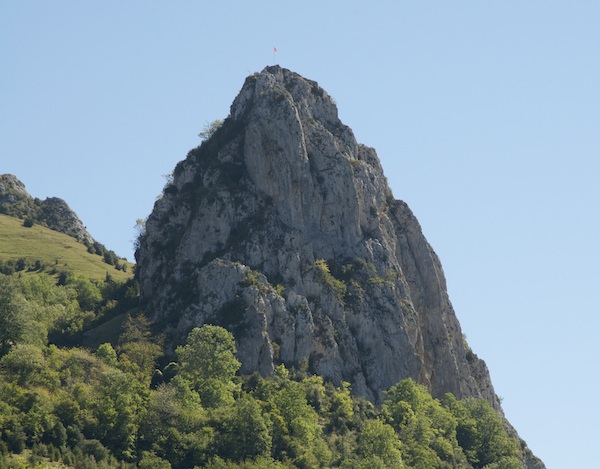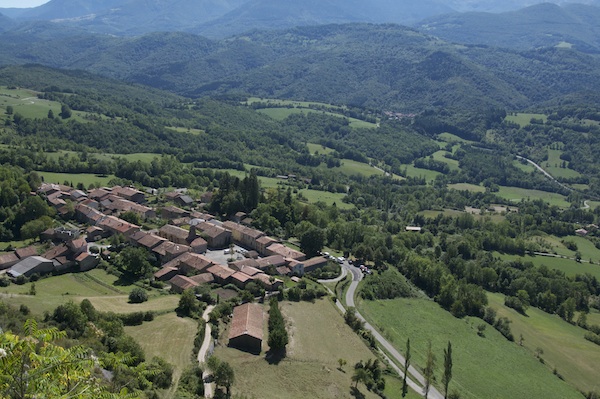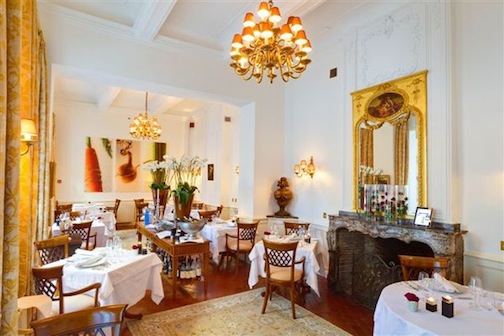Chateau Aguilar
Gaston and I caught the Friday market in Foix, took a heap of photos as the light was crystal clear—that would have been the first day of Autumn light—then departed to conquer Roquefixade.
We’d been intimidated by this chateau on previous visits. The approach appears vertiginous.

Chateau Roquefixade: the wee red flag at the top of the peak marks the ruins of this Cathar stronghold.
First visit to the area, which encompassed only six days, we gazed at it from Montségur and noted the cathar-cross flag flying at the top of the peak. On visit #2, we explored the town at the base of the cliff, climbed to the rock face, then decided, “Another day.” I believe a mild case of food poisoning or airplane stomach-bug played a role in that choice.
Even this time ’round, as we drove towards it from the west and saw how steep the outcrop on which the ruins are perched, Gaston and I were each dreading the endeavour. But, of course, we didn’t say anything. Which I think is mighty big of Gaston, who has confessed to me that, actually, he really doesn’t care for hiking, and especially doesn’t care for hiking up steep inclines, especially when it is warm out.
Does this mean he was humouring me? Who cares!
It turns out the hike to the chateau is deceptive: it isn’t nearly as rigorous as it appears from up the valley or from the village.

At the base of the village, overlooking the valley to the southwest, was a small “villa” (modern house) with a million-dollar view and cracks so large in the walls, you can see into the interior. Said house is for sale “on condition of unbuilding.” The edge of the hill beneath the house is subsiding. What a heartbreak for the owner who invested.
Don’t believe me? The trail winds around the base of the rock to the back side of the pog, then ascends at fairly reasonable, albeit still steepish, incline to the back of the fortress.
And we saw our first Griffin vulture whilst lounging at the top: a freaking HUGE, black bird that was riding the thermals off the crest.
The word la peyre is a derivation of la pierre, or stone. We have encountered a number of places whose names incorporated “peyre.”
Chateau Peyrepertuse, which translates roughly into (tee hee) Stone-Whooping cough Castle—the spectacular mountaintop ruin of a former Cathar fortress, then French-border fortress and chapel to Saint-Louis/Louis IX, north of the town of Maury, in the Aude.
Peyrefitte-du-Razès—a farming village in the Razès region of the Aude, where we’ve hiked.
The double-hitter Peyrie-et-Peyrols—a hamlet near Mirepoix.
La Peyre—a village built into the cliff, close the the Millau Viaduct in the upper Tarn. These kinds of places, in which past architects and builders took advantage of how rivers now far below had eroded overhangs, caves and natural shelters out of their former banks to erect shelters, Anasazi-style, are called villages des troglodytes, or villages of the cave dwellers. The original church in La Peyre, now a private residence and art gallery, is once of the cave dwellings.
One of the most renowned troglodyte villages in southwest France is Minèrve (in the Minèrvois region of Languedoc, funnily enough). Alerted to its potential by the two stars the Michelin road map marking its name, we visited this cliff-village after we picked up our month’s supply of wine from our favourite winery just to the south. We had lunch in the riverbed, the river flowing underground for most of the year.
 I’ve frequently enjoyed soups and sauces made from mirepoix stock, but this was the first time I’d had the actual mixture of chopped celery, carrots and onion that is called mirepoix explicitly showcased on my plate.
I’ve frequently enjoyed soups and sauces made from mirepoix stock, but this was the first time I’d had the actual mixture of chopped celery, carrots and onion that is called mirepoix explicitly showcased on my plate.
Gaston and I were enjoying the Friday fixed lunch at le Ciel d’Or, the restaurant at the Relais Royal hotel in Mirepoix, France. Chef Rogier van den Biggelaar, here in Mirepoix-the-town, clearly is proud of his position’s occupational, geographic and historical connections to mirepoix-the-food. The aromatic mixture, which forms the flavour base of many stocks, soups, stews and sauces, is named for Charles-Pierre-Gaston François de Lévis, duke of Lévis-Mirepoix, whose family had ruled the area since the 11th century. Mirepoix-the-lord employed the cook credited with establishing and codifying mirepoix-the-cooking-technique within the canon of French cuisine in the 18th century.
Our meal in present-day Mirepoix-the-town was both simple and simply delightful.
It started with a salad featuring a few leaves of crisp oak-leaf lettuce that cupped a generous spoonful of pink foam redolent of tomato roasted just long enough to concentrate the fruit’s sugars. Slices of vine-ripened cherry tomatoes, a drizzle of bright olive oil, and a lick of balsamic reduction lifted the dish into art, both visually and gastronomically.
But the main course was, of course, the main attraction. The menu provided just one offering: roast pork with brunoise.
Brunoise consists of a small-dice mirepoix cooked with diced ham or pork belly.
In other words, we were going to lunch on mirepoix in Mirepoix.
The chef had highlighted the natural flavours within the mirepoix, and as soon as the plates were brought into the dining room, the aromatics filled the high-ceilinged room. Steeped in a rich, savoury sauce made from the reduced juices of the pork and the vegetables, this mirepoix consisted of orange, and translucent green and golden flavour jewels that seduced the senses and silenced Gaston and I. The tiny cubes had cooked only briefly and remained satisfyingly firm in texture. This dish, so commonly relegated to the background of everyday cooking, was both revelatory and familiar, pleasantly astounding us with the fullness of its flavour on the one hand and soothing us with the comfort of an old friend on the other.
The four generous slices of roasted pork loin we were each served were tender, flavorful, and moist, with a thin, slightly chewy, slightly caramelized crust, and were perfectly set off by the brunoise.
We both would have been content if the meal had ended with this main course. Being a weekday in September, the restaurant was quiet. The staff allowed us time to sip our wine and appreciate the lingering taste-memories before presenting the sweet course—a trio of small taste treats that pleased the palate without burdening the belly. Gaston particularly enjoyed the berry smoothie that was served in a shot glass, while I appreciated the tiny tiramisu.
Coffee, of course, completed the meal.
Great to see Ingrid and Peter on their way from Toulouse to Aix. We met, we drank, we walked, we drank some more, we ate, we drank, we ate, and ate, we walked, we ate again, we lounged in the sun on the terrace, and then ate and drank again.
We hope the sun follows you. (Because you took it with you!)
“Who comes to France to make soup?” asks Gaston.
“What more French thing to do than to boil up a carcass with some mirepoix to make potage?” Mimi responds.
Making soup is part of our Monday ritual at Montplaisir. First, visit the Monday morning Mirepoix market and purchase produce for the week. Next, go to the bakery and stock up on baguettes and other breads to last the next 36 hours. Last stop on the excursion: go by the rotisserie wagon to pick up lunch: one whole chicken and a carton of potatoes roasted in a pan under the turning chickens to catch all their jus (and fat).
Back to Montplaisir, where Gaston debones the bird and sets the skeletal bits to boil in a potful of water on the stove. Mimi makes a green salad and slices bread. They eat; the carcass simmers; they sip blanquette; the carcass simmers; they clean up; the carcass simmers; they find their current reading material and lounge on the terrace; the carcass simmers. At last, Mimi strains the stock and sets it to cool, and Gaston brings the resulting chicken trash up to the dustbins at the top of the road.
Then, the creative part: consolidating and taking care of many of the bits in the frigo—that last carrot from the previous week’s trip to the market, the lonely, withering stalk of celery, the handful of leek leaves and half an onion, the leftover potatoes and bits of meat from lunch, the rice from the previous night’s supper, and the herbs harvested from fields and trailsides during the week’s hikes.
Different each time. Satisfying every time.
Other kitchen adventures include:
Last time, Mimi tried cooking rabbit stew, but ended up with stewed leather instead.
On our first full day in France, we ventured down the River Tarn at the suggestion of our B&B hosts to explore the hilltop bastide villages that the region is known for.
Click on each gallery image for more information.